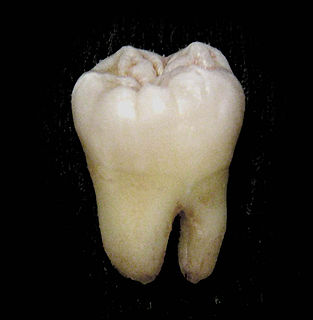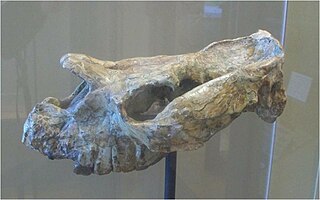See also
- South American land mammal age - list of fossils from this age and site
- Fossils of Chile
The fossil Tinguiririca fauna, entombed in volcanic mudflows and ash layers at the onset of the Oligocene, about 33-31.5 million years ago, [1] represents a unique snapshot of the history of South America's endemic fauna, which was extinguished when the former island continent was joined to North America by the rising Isthmus of Panama. The fossil-bearing sedimentary layers of the Abanico Formation were first discovered in the valley of the Tinguiririca River, high in the Andes of central Chile. The faunal assemblage lends its name to the Tinguirirican stage in the South American land mammal age (SALMA) classification.
The endemic fauna bridges a massive gap in the history of those mammals that were unique to South America. [2] Paleontologists knew the earlier sloth and anteater forebears of 40 mya, but no fossils from this previously poorly sampled transitional age had been seen. Fossils of the Tinguiririca fauna include the chinchilla-like earliest rodents discovered in South America, [3] a wide range of the hoofed herbivores called notoungulates, a shrew-like marsupial and ancestors of today's sloth and armadillos. Many of the herbivores have teeth adapted to grass-eating; though no plant fossils have been recovered, the high-crowned hypsodont teeth, protected by tough enamel well below the gumline, identifies grazers suited to a gritty diet. "The proportion of hypsodont taxa relative to other dental types generally increases with the amount of open habitat," John Flynn explained in Scientific American (May 2007) "and the Tinguiririca level of hysodonty surpasses even that observed for mammals living in modern, open habitats such as the Great Plains of North America." Statistical analyses of the number of species categorized by body size ("cenogram" analysis, an aspect of body size scaling) and of their broad ecological niches ("macroniche" analysis) bears out the existence of dry grasslands. Previously, no grassland ecosystem anywhere had been identified prior to Miocene systems fifteen million years later than the Tinguiririca fauna. Grasslands spread as the Earth's paleoclimate grew cooler and drier.
New fossils were uncovered of the New World monkeys and caviomorph rodents— the group that includes the capybara— which are known not to have evolved in situ. Some of the new fossils demonstrate by the form of their teeth that they lie closer to African fossil relatives than to the North American ones, which previously had been assumed to have rafted to the island continent. Now it appears that some may have made the crossing of a younger, much narrower Atlantic Ocean. A notable discovery was the miniature skull of a delicate progenitor of New World marmosets and tamarins; it has been given the name Chilecebus carrascoensis .
The first of the fossils were found in 1988. Since then, in strata representing repeated catastrophic lahar events, more than 1500 individual fossils have been recovered from multiple sites in the region, ranging in age from 40 to 10 mya. The mammal species Archaeotypotherium tinguiriricaense is named after the site.

The molars or molar teeth are large, flat teeth at the back of the mouth. They are more developed in mammals. They are used primarily to grind food during chewing. The name molar derives from Latin, molaris dens, meaning "millstone tooth", from mola, millstone and dens, tooth. Molars show a great deal of diversity in size and shape across mammal groups.
Hypsodont is a pattern of dentition with high-crowned teeth and enamel extending past the gum line, providing extra material for wear and tear. Some examples of animals with hypsodont dentition are cows and horses; all animals that feed on gritty, fibrous material. The opposite condition is called brachydont.

The term Hystricomorpha has had many definitions throughout its history. In the broadest sense, it refers to any rodent with a hystricomorphous zygomasseteric system. This includes the Hystricognathi, Ctenodactylidae, Anomaluridae, and Pedetidae. Molecular and morphological results suggest the inclusion of the Anomaluridae and Pedetidae in Hystricomorpha may be suspect. Based on Carleton & Musser 2005, these two families are treated here as representing a distinct suborder Anomaluromorpha.

Peltephilus, the horned armadillo, is an extinct genus of dog-sized, armadillo xenarthran mammals which first inhabited Argentina during the Oligocene epoch, and became extinct in the Miocene epoch. Notably, the scutes on its head were so developed that they formed horns. Aside from the horned gophers of North America, it is the only known fossorial horned mammal.

Adinotherium is an extinct genus of Toxodontidae, large bodied hoofed ungulates which inhabited South America during the Middle to Late Miocene, from 17.5—6.8 Ma and existed for approximately 10.7 million years, Santacrucian to Huayquerian in the South American land mammal ages (SALMA). Fossils of Adinotherium have been found in the Santa Cruz and Ituzaingó Formations of Argentina and the Chucal and Río Frías Formations of Chile.

Leontiniidae is an extinct family comprising eleven genera of notoungulate mammals known from the Middle Eocene (Mustersan) to Late Miocene (Huayquerian) of South America.

Mesotheriidae is an extinct family of notoungulate mammals known from the Eocene through the Pleistocene of South America. Mesotheriids were small to medium-sized herbivorous mammals adapted for digging.
The Casamayoran age is a period of geologic time within the Early Eocene epoch of the Paleogene, used more specifically within the South American land mammal age (SALMA) classification. It follows the Riochican and precedes the Mustersan age.
The Mustersan age is a period of geologic time within the Eocene epoch of the Paleogene, used more specifically within the South American land mammal age (SALMA) classification. It follows the Casamayoran and precedes the Divisaderan age.
The Divisaderan age is a South American land mammal age, covering a period of geologic time within the Middle and Late Eocene epochs of the Paleogene. It follows the Mustersan age and is followed by the Tinguirirican age.
The Tinguirirican age is a period of geologic time within the Late Eocene and Early Oligocene epochs of the Paleogene, used more specifically within the SALMA classification in South America. It follows the Divisaderan and precedes the Deseadan age.
The Deseadan age is a period of geologic time within the Oligocene epoch of the Paleogene to the Early Miocene epoch of the Neogene, used more specifically within the SALMA classification of South America. It follows the Tinguirirican and precedes the Colhuehuapian age.
The Colhuehuapian age is a period of geologic time within the Early Miocene epoch of the Neogene, used more specifically within the SALMA classification in South America. It follows the Deseadan and precedes the Santacrucian age.
The Friasian age is a period of geologic time within the Early Miocene epoch of the Neogene, used more specifically within the SALMA classification of South America. It follows the Santacrucian and precedes the Colloncuran age.
Pseudoglyptodon is a genus of extinct sloths from South America. The type species is Pseudoglyptodon sallaensis.
LACM 149371 is an enigmatic fossil mammalian tooth from the Paleogene of Peru. It is from the Santa Rosa fossil site, which is of uncertain age but possibly late Eocene or Oligocene. The tooth is poorly preserved and may have been degraded by acidic water or because it passed through a predator's digestive tract. Its largest dimension is 2.65 mm. It is triangular in shape and bears six cusps that surround the middle of the tooth, where there are three basins (fossae). Crests connects the cusps and separate the fossae. The microscopic structure of the enamel is poorly preserved.
The Grit, not grass hypothesis is an evolutionary hypothesis that explains the evolution of high-crowned teeth, particularly in New World mammals. The hypothesis is that the ingestion of gritty soil is the primary driver of hypsodont tooth development, not the silica-rich composition of grass, as was previously thought.

Abanico Formation is a 3 kilometres (9,800 ft) thick sedimentary formation exposed in the Andes of Central Chile. The formation has been deposited in a timespan from the Eocene to the Miocene. Abanico Formation's contact with the overlying Miocene Farellones Formation has been the subject of differing interpretations since the 1960s. A small part of the formation crops out in the Mendoza Province of western Argentina.
Groeberiidae is a family of strange non-placental mammals from the Eocene and Oligocene epochs of Patagonia, Argentina and Chile, South America. Originally classified as paucituberculate marsupials, they are now argued to be late representatives of the allothere clade Gondwanatheria.

Cura-Mallín Group is a heterogeneous group of volcano-sedimentary formations of Oligocene-Miocene age, Colhuehuapian to Laventan in the SALMA classification, in south-central Chile and nearby parts of Argentina. The sediments belonging to the group were deposited in a lacustrine environment and alongside rivers in an intra-arc basin. Southeast of Laguna del Laja Cura-Mallín Group has a thickness of more than 1,800 metres (5,900 ft). The sediments making up the group deposited in an interval between 22 and 8 million years ago.